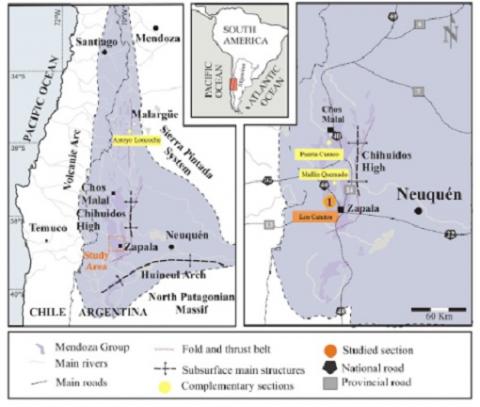M. Kohan Martínez, D.A., Kietzmann, M.P. Iglesia Llanos, H.A. Leanza, T. Luppo
2 018
Journal of South American Earth Sciences Volume 85, August 2018, Pages 209-228
A cyclostratigraphic and paleomagnetic study was carried out in the lower part of the Vaca Muerta Formation, Los Catutos Member (Lower to lowermost Upper Tithonian) at the southern region of the Sierra de la Vaca Muerta, Neuquén Basin, west-central Argentina. The Vaca Muerta Formation is known for its unconventional resource potential and its exceptional behaviour as a world-class source rock. The studied section is c. 90 m thick and is characterized by decimetre-scale rhythmic alternations of marls, mudstones and limestones, showing a well-ordered hierarchy of cycles. Elementary cycles, bundles and superbundles were recognized with frequencies within the Milankovitch spectrum band. A total of 280 standard specimens collected from 35 paleomagnetic sampling horizons, dated with ammonites, were analyzed. The quality and primary origin of the characteristic magnetization was proved through the corresponding reversal test. A magnetostratigraphic scale was thus constructed that comprises 5 reverse and 4 normal polarity intervals, spanning the Andean Virgatosphinctes andesensis (ex mendozanus) (Lower Tithonian) to Windhauseniceras internispinosum (lowermost Upper Tithonian) ammonite Zones. Polarities were correlated with the GPTS 2016 using the equivalences between the Andean and Standard ammonite zones which, allowed to interpret that Los Catutos section was deposited between M22r to M20n Subchrons. By means of the correlation between the cyclostratigraphic and magnetostratigraphic scales, it was possible to date the Tithonian succession with unprecedented precision. Rock magnetic studies indicate that the remanence is carried by titanomagnetite.
https://www.sciencedirect.com/science/article/pii/S0895981118301123

